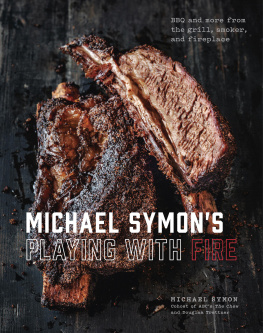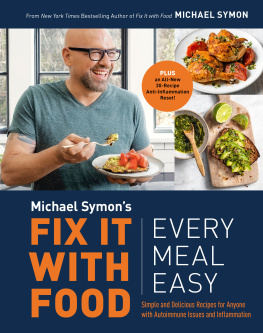ACKNOWLEDGMENTS
No chef gets anywhere without a fleet of people behind him and in this Ive been incredibly lucky, truly blessed with great family, an amazing wife, and an excellent staff, people who have stayed with me for so many years in a transitory industry.
I want to thank my mom, Angel, my dad, Dennis, my sister, Nikki, and my grandparents, who made cooking and eating together a pleasure from the beginning. Of course I want to thank Lizzie and Kyle. I was lucky beyond words that Liz happened to be working at the place where I found my first job out of culinary school. Id like to thank Lizzies parents as well, Russ and Sherla. Thank you, Doug Petkovic, one of my oldest and dearest friends, who became my business partners. And I cant forget James Sammon, best friend, and more important, my lawyer, who, God bless him, has traded countless legal-work hours for food.
Im grateful to my staff and chefs, past and present, especially Frank Rogers, Matt Harlan, Derek Clayton, Cory Barrett, Jonathon Sawyer, and Jon Seeholzer. Theyre the ones who truly keep the businesses running. And my great assistant, Rebecca Yody, keeps me running. Theyve become family too.
Thank you Scott Feldman and all the folks at 212 Management, and I also want to say thanks to my Food Network family.
Books, like restaurants, take a team of people, and Im grateful to all the people who helped to make this book happen: Michael and Donna Ruhlman and Heidi Robb here in Cleveland, and in New York, my agent, Elizabeth Kaplan, and my editor, Rica Allannic; creative director, Marysarah Quinn; managing editor, Amy Boorstein; and production manager, Kim Tyner.
To all, thank you.
A bell went off in my head when she said it. She was a cook at Michael Symons Lola, the most popular restaurant in Cleveland, working day prep and I was beside her as part of my reporting on Michael Symon for my book The Soul of a Chef. We roasted and peeled beets and red peppers, made the chocolate pudding, washed the arugula, sliced the red onions, grilled the portobellos, and prepped the artichokes.
She stopped moving and said, You know what I like about Michaels food? Its the kind of food you can do at home. She paused for an example but needed to go only as far as her countertop, to the artichokes, for her favorite dish: grilled halibut over a roasted artichoke salad with red peppers, basil vinaigrette, and preserved lemon. I would never have thought to put halibut on an artichoke salad, she said.
I thought, Do-at-home foodexactly. Thats it.
Symons food was interesting and satisfying and reliant on good technique, but in the end it was very simple food without pretension or self-conscious chefiness. A piece of fish over a salad, or with a little salad on top and a warm vinaigrette. Corn crpes with some shredded duck inside and a little barbecue sauce. A chicken dish that was so successful he grew to despise it: he couldnt take it off the menu because women threatened never to come back if he did. Rigatoni pasta tossed in a cream sauce flavored with rosemary and goat cheese (see ); if you have some leftover chicken, a one-dish meal comes together in the time it takes the rigatoni to cook. Anyone can do it, there is almost no technique whatsoever, and yet it is good enough to earn national accolades from the food media. This guy, this wrestler, this blue-collar boy from Cleveland a Food & Wine best-chef award? Really?
Id known Symon for a couple years before he sprang onto the national playing field. I had spent some time in the kitchen at his previous restaurant, but after the award in 1998 I could write about him for a broader audience. What was it about this guy that was so magnetic? What made his food both so good and also so seemingly simple?
One of the qualities of his dishes is their mechanical ingenuity, born of necessity in the chaotic bottom-line restaurant business. When you have nothing more than a shoebox kitchen and a six-burner range to feed two hundred people, youre forced to think a little harder. The aforementioned pasta dish needs only one pan to come together. (If I cant finish a dish in two pans, I wont do it, Symon always says, summing up his hot-line philosophy.) Very few of his dishes rely on elaborate reductions; he uses hardly any stocks at all. Give him a warm vinaigrette over a gluey veal-stock reduction any day. His cooking is focused.
I remember eating at the bar one night after Id finished my scribbling. I liked to rib Symon about how little sauce he used. Id say, Sorry, Michael, I just dont like dry food. And hed say, Yeah, but I sell more wine this way! And hed howl and keep cooking.
I ordered the brick-roasted chicken. He hadnt used any sauce, it seemed, and he hadnt used any stock. Half a roasted chicken stuffed with seared hen-of-the-woods mushrooms that came straight out of the broiler was placed on a mound of red potatoes sauted with arugula, some cream, and some mustard. The finish the dish in two pans or fewer rule.
Michael threw some cooked red potatoes into a saut pan, followed by a handful of arugula. The greens released some of their liquid. He then added a little cream to the pan, which helped to heat up the potatoes and sweeten the spicy greens, and a spoonful of mustard for acidity, balance. When the chicken came out of the broiler, he poured the creamy potato-arugula side dish onto a plate, set the chicken right on top of that, and let it rest there for a few minutes. As it rested, the chicken dropped its natural juices and mushroom juices over the potatoes and into the mustard cream, creating an extraordinary and complex sauce all on its own. It was a kind of self-saucing dish. No one had to toil over a classic stock or make a pan jus or even ladle sauce out of a nearby bain-marie. The dish was making its own sauce right there and all he needed was to squirt a few drops of balsamic to finish it. Ingenious. Try it yourself (see ). This is how he could turn tables four times on a Saturday night and not keep losing his line cooks.
Symons food isnt simplistic; it is just simple and economical, the two main criteria for home cooking. Another reason his placement on Food & Wines 1998 best-new-chefs list was remarkable was the price point his restaurant had to hit. His market is a meat-and-potatoes crowd unwilling to pay New York City prices and suspicious of anyone trying to charge them. The nine other chefs on the Food & Wine list had white-tablecloth dining rooms serving expensive ingredients at high prices, the kind of ingredients that tend to impress foodie magazines but have a high food cost. These chefs had check averages that ranged from $70 to $150.
Hanging out at Lola early one evening, I saw a man and a woman, both dressed in fine business attire, approach the bar for an after-dinner drink. Bartender Frankie Ritz (now managing the Detroit restaurantanother reason for Symons success: he takes care of people and they stay with him), polishing a glass, with a ready smile asked, How was your meal? The man swirled his Cognac and said, I had the halibut. It was out of this world. Most expensive thing on the menu. Nineteen ninety-five. Gimme the most expensive thing on the menu. Nineteen ninety-five. The man chuckled and shook his head. Evidently one of those New York City types we get around here every now and then.
Michael Symon knew his market and in 1998, he wouldnt put an entre on the menu for more than twenty dollars. Symon earned a best-new-chef award by doing thirty-dollar check averages per person. Thats what was amazing. Hed become one of the best chefs in the country by serving do-at-home food. Symon was so successful, when a developer needed an anchor for an entire street redevelopment project, he called on Michael. Michael shut down Lola to rebuild it on the new street in downtown Cleveland and reopened the original restaurant as Lolita.








